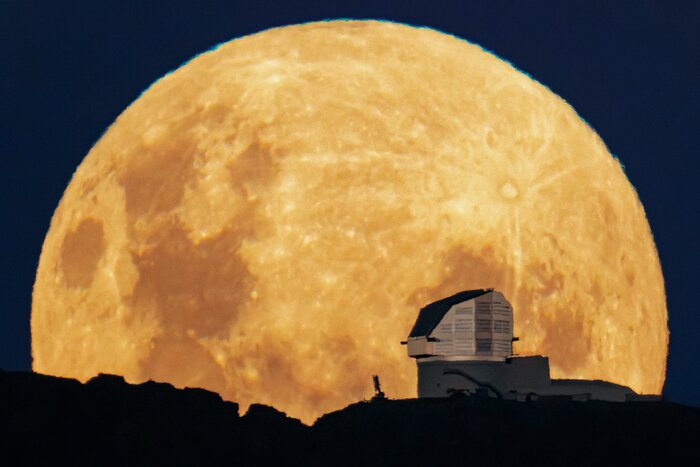From Cerro Pachón to the Moon
NSF–DOE Vera C. Rubin Observatory atop Cerro Pachón in Chile is outlined against the full Moon rising above the horizon. A trick of perspective has enlarged the Moon beyond the size we’d naturally see it on Earth in this Image of the Week.
Often regarded as an ‘enemy’ of non-lunar astronomers because of its brightness, the beauty of Earth’s natural satellite cannot be ignored. On the right side of the Moon in this image is the large and relatively young Tycho crater, with its distinctive ray system prominently spreading across the lunar surface. On the bottom and left side are large, dark maria, basaltic plains that formed during the early life of the Moon 1.2–4 billion years ago. The largest of the maria in this image is the Sea of Tranquility, the first site on the Moon visited by humans.
This image was captured during the final phase of the construction of Rubin Observatory. Starting in 2025, Rubin will conduct a decade-long survey of the Southern Sky called the Legacy Survey of Space and Time (LSST) and generate about 20 terabytes of data per night. Rubin Observatory is jointly funded by the U.S. National Science Foundation (NSF) and the U.S. Department of Energy (DOE). Rubin Observatory will begin science operations in late 2025. Rubin Observatory is a Program of NSF NOIRLab, which, along with SLAC National Accelerator Laboratory, will jointly operate Rubin.
This photo was taken by Hernán Stockebrand, a NOIRLab Audiovisual Ambassador.
Credit:RubinObs/NOIRLab/SLAC/NSF/DOE/AURA/H. Stockebrand
About the Image
| Id: | iotw2431a |
| Type: | Photographic |
| Release date: | July 31, 2024, noon |
| Size: | 4268 x 2848 px |
About the Object
| Name: | Vera C. Rubin Observatory |
| Category: | Vera C. Rubin Observatory |
